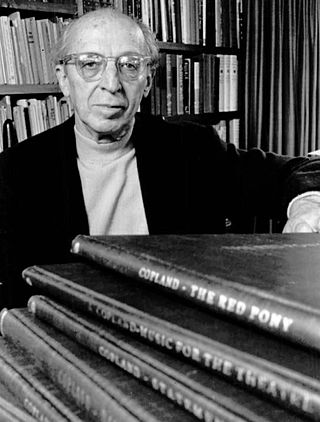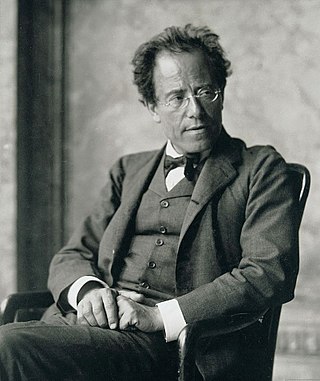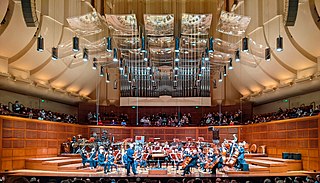Related Research Articles

Aaron Copland was an American composer, critic, writer, teacher, pianist, and conductor of his own and other American music. Copland was referred to by his peers and critics as the "Dean of American Composers". The open, slowly changing harmonies in much of his music are typical of what many consider the sound of American music, evoking the vast American landscape and pioneer spirit. He is best known for the works he wrote in the 1930s and 1940s in a deliberately accessible style often referred to as "populist" and which he called his "vernacular" style. Works in this vein include the ballets Appalachian Spring, Billy the Kid and Rodeo, his Fanfare for the Common Man and Third Symphony. In addition to his ballets and orchestral works, he produced music in many other genres, including chamber music, vocal works, opera, and film scores.

Gustav Mahler was an Austro-Bohemian Romantic composer, and one of the leading conductors of his generation. As a composer he acted as a bridge between the 19th-century Austro-German tradition and the modernism of the early 20th century. While in his lifetime his status as a conductor was established beyond question, his own music gained wide popularity only after periods of relative neglect, which included a ban on its performance in much of Europe during the Nazi era. After 1945 his compositions were rediscovered by a new generation of listeners; Mahler then became one of the most frequently performed and recorded of all composers, a position he has sustained into the 21st century.

The San Francisco Symphony, founded in 1911, is an American orchestra based in San Francisco, California. Since 1980 the orchestra has been resident at the Louise M. Davies Symphony Hall in the city's Hayes Valley neighborhood. The San Francisco Symphony Youth Orchestra and the San Francisco Symphony Chorus (1972) are part of the organization. Michael Tilson Thomas became the orchestra's music director in 1995, and concluded his tenure in 2020 when Esa-Pekka Salonen took over the position.

The Symphony No. 8 in E-flat major by Gustav Mahler is one of the largest-scale choral works in the classical concert repertoire. As it requires huge instrumental and vocal forces it is frequently called the "Symphony of a Thousand", although the work is normally presented with far fewer than a thousand performers and the composer disapproved of the name. The work was composed in a single inspired burst at his Maiernigg villa in southern Austria in the summer of 1906. The last of Mahler's works that was premiered in his lifetime, the symphony was a critical and popular success when he conducted the Munich Philharmonic in its first performance, in Munich, on 12 September 1910.

Serge Koussevitzky was a Russian and American conductor, composer, and double-bassist, known for his long tenure as music director of the Boston Symphony Orchestra from 1924 to 1949.

Robert Eugene Ward was an American composer who is best remembered for his opera The Crucible (1961) after the 1953 play of the same name by Arthur Miller. He was awarded the Pulitzer Prize for Music for that opera in 1962.

Michael Tilson Thomas is an American conductor, pianist and composer. He is Artistic Director Laureate of the New World Symphony, an American orchestral academy in Miami Beach, Florida, Music Director Laureate of the San Francisco Symphony, and Conductor Laureate of the London Symphony Orchestra. He gave his final performance with the San Francisco Symphony in January 2024 while fighting brain cancer. He led the Houston Symphony Orchestra and Chorus in Beethoven's 9th Symphony on November 14, 2024.

Adele Addison is an American lyric soprano who was a figure in the classical music world during the 1950s and 1960s. Although she did appear in several operas, Addison spent most of her career performing in recital and concert. Her performances spanned a wide array of literature from the Baroque period to contemporary compositions. She is best remembered today as the singing voice for Bess in the 1959 movie, Porgy and Bess. Known for her polished and fluent tone, Addison made a desirable Baroque vocal artist. She can be heard on numerous recordings, of which her Baroque performances are perhaps her best work. Many of her recordings were made with the New York Philharmonic under the baton of Leonard Bernstein.
Jan (Janice) DeGaetani was an American mezzo-soprano known for her performances of contemporary classical vocal compositions.

Connotations is a classical music composition for symphony orchestra written by American composer Aaron Copland. Commissioned by Leonard Bernstein in 1962 to commemorate the opening of Philharmonic Hall in New York City, United States, this piece marks a departure from Copland's populist period, which began with El Salón México in 1936 and includes the works he is most famous for such as Appalachian Spring, Lincoln Portrait and Rodeo. It represents a return to a more dissonant style of composition in which Copland wrote from the end of his studies with French pedagogue Nadia Boulanger and return from Europe in 1924 until the Great Depression. It was also Copland's first dodecaphonic work for orchestra, a style he had disparaged until he heard the music of French composer Pierre Boulez and adapted the method for himself in his Piano Quartet of 1950. While the composer had produced other orchestral works contemporary to Connotations, it was his first purely symphonic work since his Third Symphony, written in 1947.
Des Knaben Wunderhorn is a series of songs with music by Gustav Mahler, set either for voice and piano, or for voice and orchestra, based on texts of German folk poems chosen from a collection of the same name assembled by Achim von Arnim and Clemens Brentano and published by them, in heavily redacted form, between 1805 and 1808.
Aaron Copland's Clarinet Concerto was written between 1947 and 1949, although a first version was available in 1948. The concerto was later choreographed by Jerome Robbins for the ballet Pied Piper (1951).
The Piano Variations of American composer Aaron Copland were written for piano solo from January to October 1930. They were dedicated to American writer and literary critic Gerald Sykes, and were originally published in 1932 by Cos Cob Press, which merged with Arrow Music Press in 1938 and was taken over by Boosey & Hawkes in 1956. The approximate performance time is 11 minutes.
Old American Songs are two sets of songs arranged by Aaron Copland in 1950 and 1952 respectively, after research in the Sheet Music Collection of the Harris Collection of American Poetry and Plays, in the John Hay Library at Brown University. Originally scored for voice and piano, they were reworked for baritone and orchestra.

Lucijan Marija Škerjanc was a Slovene composer, music pedagogue, conductor, musician, and writer who was accomplished on and wrote for a number of musical instruments such as the piano, violin and clarinet. His style reflected late romanticism with qualities of expressionism and impressionism in his pieces, often with a hyperbolic artistic temperament, juxtaposing the dark against melodic phrases in his music.
The orchestral song is a late romantic genre of classical music for solo voices and orchestra.
The Short Symphony, or Symphony No. 2, is a symphony written by the American composer Aaron Copland from 1931 to 1933. The name derives from the symphony's short length of only 15 minutes. The work is dedicated to Copland's friend, the Mexican composer and conductor Carlos Chávez. The symphony's first movement is in sonata-allegro form, and its slow second movement follows an adapted ternary form. The third movement resembles the sonata-allegro but has indications of cyclic form. The composition contains complex rhythms and polyharmonies, and it incorporates the composer's emerging interest in serialism as well as influences from Mexican music and German cinema. The symphony includes scoring for a heckelphone and a piano while omitting trombones and a percussion section. Copland later arranged the symphony as a sextet.
References
- ↑ Copland A. and Perlis, V. (1989) Copland Since 1943, p. 159. New York: St Martins's Press.
- ↑ Copland and Perlis (1989) [ page needed ]
- ↑ "Aaron Copland – Twelve Poems of Emily Dickinson". Boosey & Hawkes. Retrieved 18 March 2018.
- ↑ "Poems (8) of Emily Dickinson for voice & orchestra (arr. from 12 Poems of Emily Dickinson)". Allmusic.
- ↑ Baker, Dorothy Z. "Aaron Copland's Twelve Poems of Emily Dickinson: A Reading of Dissonance and Harmony" (PDF). Retrieved 2024-02-08.
- 1 2 "PROGRAM NOTES - Aaron Copland – Eight Poems of Emily Dickinson" (PDF). Archived from the original (PDF) on 2010-06-21. Retrieved 2018-03-18.